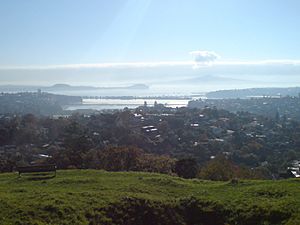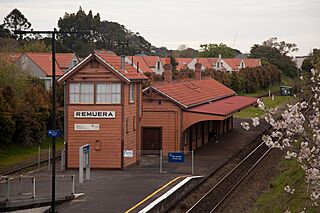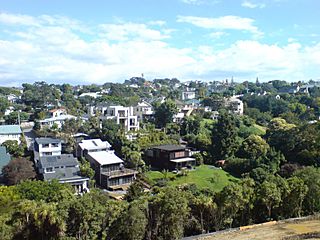Remuera facts for kids
Quick facts for kids
Remuera
|
|
|---|---|
|
Suburb
|
|
| Country | New Zealand |
| Local authority | Auckland |
| Electoral ward | Ōrākei ward |
| Local board | Ōrākei Local Board |
| Area | |
| • Land | 825 ha (2,039 acre) |
| Population
(June 2023)
|
|
| • Total | 23,570 |
| Train station(s) | Remuera Railway Station |
|
|
||
Remuera is a lovely suburb in Auckland, New Zealand. It is located four kilometres southeast of the city centre. You'll find many large, beautiful houses here, some from the early 1900s (Edwardian style) and others from the mid-1900s. It's known as a 'leafy' suburb because of its quiet, tree-lined streets.
There are lots of green spaces, especially Ōhinerau / Mount Hobson. This is a volcanic cone with amazing views from the top. You can see Waitematā Harbour and Rangitoto from there.
Remuera stretches from Hobson Bay and the Ōrākei Basin in the north and east, all the way to State Highway 1 in the southwest. It's surrounded by other suburbs like Ōrākei, Meadowbank, Saint Johns, Mount Wellington, Ellerslie, Greenlane, Epsom, Newmarket and Parnell. Many famous New Zealanders have lived in Remuera, including the explorer Sir Edmund Hillary and the race car driver Bruce McLaren.
Contents
History of Remuera
The Remuera area was very appealing to Tāmaki Māori people long ago. While much of the Auckland isthmus had few trees, Remuera had patches of woodland. These woods were home to many birds that could be caught for food. The nearby harbour and basins were also great for fishing.
The main road, Remuera Road, started as a walking track. It connected the eastern and northern parts of the Auckland area.
Early Descriptions
John Logan Campbell wrote about Remuera in the early 1800s in his book Poenamo. He described it as a beautiful place with many different trees and plants. He mentioned the palm fern-tree, karaka, and puriri. He also wrote about the sounds of the tui bird and the sight of pigeons.
The Name Remuera
The name Remuera comes from a pā (a fortified village) called Remuwera. This pā was located on Ōhinerau / Mount Hobson. The name "Remu-wera" means "burnt edge of kilt". This name is said to remember a story where a chieftainess from Hauraki was captured. However, some people think this meaning might not be entirely accurate.
Māori History and European Settlement
Around 1741, the Te Wai-o-Hua iwi (tribe) moved away from the area. Then, the Ngāti Whātua and Te Taoū iwi came. Later, these tribes joined with Te Roroa and Te Uri-o-Hau to form Ngāti Whātua-o-Ōrākei. This group is the main iwi on the Tāmaki isthmus today.
In May 1844, a very large Māori feast happened in Remuera. It was organized by the Waikato iwi. About 4000 Māori and many Pākehā (Europeans) attended. The celebration lasted a week. They served huge amounts of food and drinks, including 11,000 baskets of potatoes, 9,000 sharks, and 100 pigs. Governor Robert FitzRoy visited the feast. During his visit, 1,600 Māori performed a haka with guns and tomahawks.
When European settlers wanted to buy land in the Tāmaki isthmus, the Māori first said no. But in 1851, Henry Tacy Kemp bought 700 acres for £5000. More land was then sold. The land was good for farming. People didn't start building many houses until the 1860s because Auckland town was a bit far away.
One of the first farmers in Remuera was Archibald Clark. He later became Auckland's first mayor in 1851. Remuera became known as the "garden suburb." It was popular with wealthy families because it offered much larger plots of land than other parts of Auckland. Many grand homes were built in the late 1800s and early 1900s. By the 1960s, smaller sections of land started to be developed.
Growth and Development
Smaller houses began to appear closer to Newmarket and along Remuera Road. The first shops opened in 1890 where Remuera Road meets Victoria Avenue. Railway stations at Newmarket and Market Road made it easier for people to travel to town. Electric trams started running in 1902, with a key route going to the Remuera shops. One of the first businesses was L.J. Keys' grocery store, which is now a café.
Remuera Road was first a dirt track. By the 1860s, the Remuera Road Board was formed to manage the area. They looked after roads, drainage, water, and power. Remuera District School opened in 1873. In the early 1900s, the Auckland electric tramway started serving Remuera Road. This caused the population to double between 1901 and 1911, reaching over 5,000 residents.
By the 1910s, many residents wanted Remuera to join Auckland City. A petition in 1912, signed by over half the ratepayers, asked for this. After some discussion, Remuera officially became part of Auckland in February 1915.
The 1920s and 1930s saw more growth in Remuera. New commercial buildings like the Avenue Buildings and Tudor Mall made the area a business centre. The first mile of Remuera Road was paved with concrete in 1921. The tram line was also expanded. Auckland City Council made improvements, like providing a free public library in 1915, which was replaced by the current building in 1926.
In 1927, the Remuera rugby league club was reformed. The Tudor Theatre cinema and dance hall opened in 1928. It was a popular spot for many years. The theatre closed in 1973, and the Tudor Mall was built there in 1980.
In 1963, a notable event occurred in Remuera. This event led to two men being sentenced to life imprisonment.
Population and People
Remuera covers about 8.25 square kilometres. It had an estimated population of 25,600 people as of June 2023.
At the 2018 New Zealand census, Remuera had a population of 23,586. This was a small increase from previous years. There were 8,028 households. The population included 11,298 males and 12,291 females. About 17.7% of people were under 15 years old.
Most people in Remuera (70.6%) are European/Pākehā. Other groups include Māori (4.0%), Pacific peoples (1.9%), and Asian (27.4%). Many people (37.4%) were born overseas.
When asked about religion, 46.4% said they had no religion. About 40.9% were Christian. Other religions included Hindu, Muslim, and Buddhist.
Many adults in Remuera have a university degree or higher (49.0%). Most people (51.1%) work full-time.
Landmarks and Features
Historic Buildings and Sites
Remuera has many interesting historic places. You can find some of them on the Remuera Heritage Walk.
- St Mark's Anglican Church: This wooden church was built in the 1860s.
- St Mark's Graveyard: This is where many well-known early Aucklanders are buried.
- Former Remuera Freemasons Hall: Built in 1880, this is the oldest purpose-built lodge building in the area.
- Saint Michael's Catholic Church: A large church built in the Italian Romanesque style, opened in 1933.
- St Luke's Presbyterian Church: This stone church from 1932 replaced an older wooden one.
- King's School: This school started in 1896 in a house called "The Tower."
- 4 Garden Road: This house was designed by a famous architect, C. Reginald Ford. It later became the "Remuera Ladies College," where Jean Batten studied.
- Skeltons Building: Built in 1928, these shops still have their original tiled fronts.
- Hellaby Building: Built in 1926 for a family who owned butcher shops.
- Remuera Pharmacy: A 1909 building for a pharmacy business.
- Cole's Building: Built in 1923, it first housed Wylies Pharmacy.
- L.J. Keys’ grocery store: This was the first shop in the area, opened in 1907.
- Former Remuera Post Office: Built in 1914.
- Brick shops: These two-storey shops from 1929 replaced the old Remuera Road Board office.
- The Remuera Library: Designed in 1928, this beautiful red brick building won awards for its design and renovations.
- Cotter House: Built around 1848, this house has a long history.
- St Paul's Methodist Church: A red brick church built in 1922.
- Saint Aidan's Anglican Church: A wooden church from 1904, known for its special entrance gate called a lychgate.
- Elmstone: A large house built in 1904.
- Hellaby House: Designed in 1921.
The Remuera Railway Station and Signal Box are also special. They were built in 1907–1908. The station is the best-preserved one in Auckland, still looking much like it did originally. It is still used for passenger trains.
Arney Road Area
Arney Road has always been a popular place to live. It's close to the city and the sea, and offers views of the Hauraki Gulf. In 1906, it was described as a very elegant street with large, beautiful homes and gardens.
The road is wide and lined with big trees. Buildings on Arney Road come from the 1800s, 1900s, and 2000s. Several of them are protected by Heritage New Zealand because of their importance.
Nature Areas and Parks
Remuera has some interesting natural areas and parks. Unlike other parts of Auckland, Remuera kept some of its native bush and woodlands.
The Ōrākei Basin is a tidal lagoon, which means its water level changes with the tides. It's a popular spot for water sports. There's a 3 km walkway around the basin where you can see local plants and animals. The basin is actually the submerged crater of an old volcano!
Mount Hobson Domain includes the volcanic cone, Ōhinerau / Mount Hobson. Māori people used this hill as a pā (a defended settlement) long ago. Later, it was used as a quarry (where stone is dug out) and for grazing animals. Ōhinerau / Mount Hobson is 143 metres high and is one of Auckland's best-preserved volcanic cones. It formed about 25,000 years ago. You can still see terraces and pits from the Māori occupation. Water reservoirs were built on the summit and lower side to supply water to the area. There's also a memorial stone seat for Remuera boys who died in WWII.
Waiatarua Reserve is to the south of Remuera Road. This area is a natural basin that sometimes floods. On old maps, it was shown as a lake, but it was mostly a swampy area. In 1918, 133 acres of this land were given to the City Council to create Waiatarua Reserve. As farms around it became houses, the swamp became a problem because of mosquitoes and smouldering fires. In 1929, a drain was built to send the water into a nearby stream that flows into the Ōrākei Basin. This system still works today. In 1934, 50 acres of the park were leased to the Remuera Golf Club, and a golf course was built.
Economy and Shops
The Remuera Town Centre has several shopping areas, including Airlie Court, Remuera Mall, Tudor Mall, Victoria Mews Arcade, and Remuera Village Green. There are about 130 shops, including a New World supermarket. There are also about 400 parking spaces.
Education
Remuera has many schools for different age groups:
- Remuera Intermediate: A school for students in years 7–8.
- Remuera School, Meadowbank School, and Victoria Avenue School: Primary schools for years 1–6.
- Baradene College of the Sacred Heart: A Catholic secondary school for girls in years 7–13.
- St Michael's Catholic School: A Catholic primary school for years 1–6.
- Mount Hobson Middle School: A private school for years 7–10.
- King's School, St Kentigern Primary School, and Saint Kentigern Girls' School: Private primary schools for years 1–8.
- Kadimah School: A Jewish primary school for years 0–8.
Remuera Golf Club
The Remuera Golf Club started in 1934, and its clubhouse was finished in 1935. The location was not perfect for a golf club because it was in a natural basin that often flooded. Old maps even showed it as a lake. It was mostly a swampy area where shallow water would appear when it rained a lot.
In 1918, 133 acres of land in the gully became Waiatarua Reserve. As the surrounding farmland became houses, the swamp caused problems. It was a breeding ground for mosquitoes, and the peaty ground would sometimes catch fire. In 1929, a drain was dug through the hill to let the water flow into a nearby stream that goes to the Ōrākei Basin. This drainage system is still used.
Fifty acres of the park were leased to the Golf Club in 1934, and a course was designed. In 1938, a new course was built because members had complained about the conditions. In 1968, the course was redesigned again, and a new clubhouse was built.
Connections to the SS Remuera
Remuera was such a well-known and desirable place around the early 1900s that a luxury ship was named after it! The SS Remuera was a steamship launched in 1911. It was one of three large ships built for the New Zealand Shipping Company. Its first journey in 1911 was from London to Wellington. In September 1914, it was the first British ship to travel through the new Panama Canal.
During the First World War, the British Government used the ship. After the war, it returned to its route between the UK and New Zealand. It was changed to carry two classes of passengers instead of three. When World War II started in 1939, it was again used by the government. Sadly, it was hit by a torpedo in the North Sea in September 1940.
Notable Residents
Many interesting people have lived in Remuera:
- Jean Batten: A famous aviator who was a student at a girls' school on Garden Road.
- Archibald Clark: Auckland's first Mayor in 1851.
- James Clark: Mayor of Auckland from 1880–1883. He lived at what is now King's School.
- Thomas Cotter: A well-known lawyer who lived on St Vincent Avenue.
- William Crowther: A Mayor of Auckland and a tram company operator.
- James Dilworth: He helped create the famous Dilworth School, which supports boys from difficult backgrounds.
- Sir Edmund Hillary: The famous mountaineer and explorer. He built a home in Remuera in 1956 and lived there until he passed away in 2008. His home was later moved to Sir Edmund Hillary Collegiate in Ōtara to house a training program for young leaders.
- Sir Paul Holmes: A well-known broadcaster.
- Alfred George Horton: The founder of The New Zealand Herald newspaper.
- Dame Rosie Horton and Michael Horton: Known for their charity work.
- Rev John Kinder: A minister at St Mark's Remuera.
- Bruce McLaren: The famous race car driver. He was born in Remuera, and his family lived above their garage on Remuera Road.
- Sir Edwin Mitchelson: An MP and Mayor of Auckland from 1903 to 1905.
- Joseph Newman: A stockbroker who built a house on St Vincent Avenue in 1848.
- James Pascoe: A well-known jeweller.
- Sir John Reed: A Supreme Court Judge.
- Hon. Joseph Tole: Minister of Justice from 1884 to 1887.
- William Chisholm Wilson: Another founder of The New Zealand Herald newspaper.
- Desley Simpson: A local council politician.
- Christopher Luxon: The current Prime Minister of New Zealand.
Images for kids








